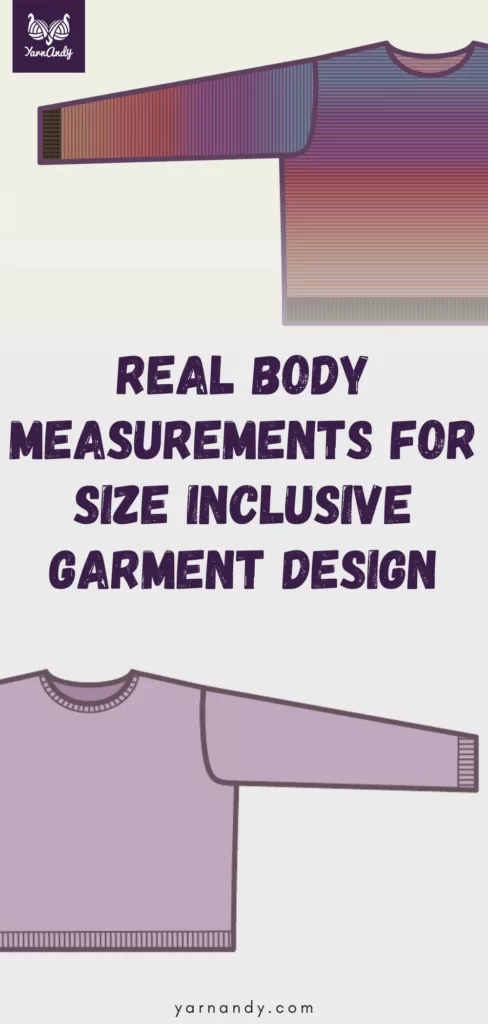These are the results from a long-term data collection project that will generate a set of size-inclusive and shape-inclusive body measurements for garment design, both crochet and knit.
I started this survey with the intention of creating a set of measurements based on actual human data, instead of data from other designers, like I did previously when developing the set of measurements that I currently use for grading garments.
If more people fill it out, I will update the charts below with the updated data.
If you are interested in crochet or knit garments that fit well, read on.
Contents
About this article on body measurements for garment design
In this blog article, I’ll be presenting the results from the survey of body measurements that I launched in March 2023.
As I mentioned in my previous article on this topic, I will be processing the data from the survey on a monthly basis.
The data included in the current version of this article was collected at the end of April 2023.
At the end of each month, I take the new data and add it to the previous data that I had processed already.
I will create new fitting curves and will use the ones at the end of the project to extrapolate measurements that I can use to design garment patterns that fit people well.
All of these measurements are taken directly from the body.
The garment measurements will vary from design to design, based on the style, ease, gauge and stitch pattern repeats used in the patterns.
This data is the basis for a range of sizes in garments that can accommodate a large section of the population.
Please add your own measurements to the data pool by filling out this form.
Data processing
I extracted the raw data from the form here and did a conversion to cm for all inch measurements.
All data is plotted against the bust measurements as values on the X axis.
I created separate worksheets for each data set and plotted each in a graph with the same X axis and varying Y axis values, depending on the type of measurement.
The X axis is the same in all graphs in order to show you how the data is distributed and to show the growth of new data, as I add it over the next months.
The graphs also include a linear fitting curve where it could be done, with the slope written in the lower right corner.
I was not able to fit a linear curve to some of the data sets, which means that more data is required or that fitting is not necessary.
Results
A. Neck circumference
As expected, the neck circumference doesn’t increase significantly with bust size. The slope of 3.3% shows this clearly.
Some people have smaller neck circumferences, some slightly larger, but all within 30-45 cm.
There is an outlier data point at over 50 cm, which we can attribute to user error when measuring or an unusually large neck.
Either way, the garment neckline measurement should not change significantly from one size to the next.
It must, however, keep in mind the construction of the garment. A pullover has to fit over the head comfortably, so the ease in the neckline needs to reflect that.
I will write a separate article about different types of ease and how different values influence the final result.
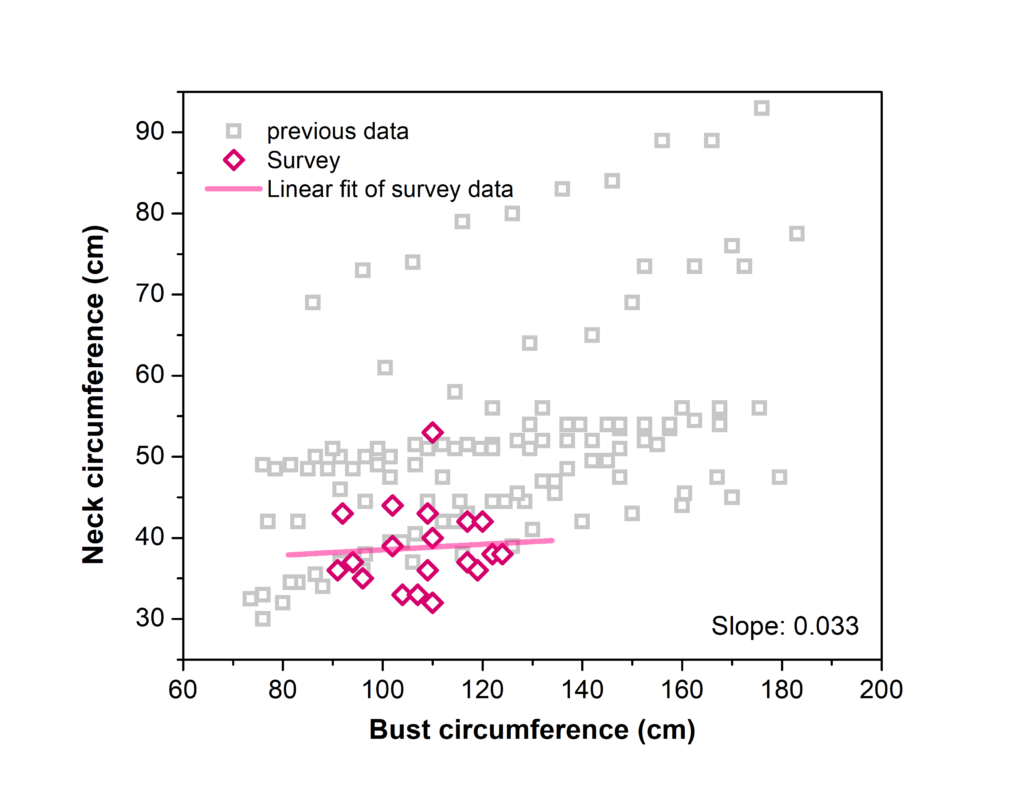
For now, we are aware the necklines do not have to increase dramatically as the bust size increases.
Where the style of the neckline makes it sit well away from the bottom of the neck at the smaller sizes, it should be similar in all sizes, since this is a mark of the design of the garment.
This is very important in warm weather garments, where designs usually have wider necklines.
B. Armscye circumference
The armscye circumference in the current data set varies between 35-55 cm.
The data is scattered because this is a type of measurement where there is a large variation in the population.
Even at the same bust size, the armscye can vary a lot, as you can see from the graph.
This means that we must take great care about designing armscyes that fit well or offering options for customizing fit.
For example, in a modified drop shoulder or a fitted sleeve garment, you can choose an armscye measurement from a different size than the bust measurement.
The lower body can be made from one size and the armhole shaping and sleeve can be made using instructions from another size that fits better.
This means that all these options need to be available in the pattern, so everyone can choose the armhole shaping and sleeve width that works for their body.
In raglan and yoke designs, this issue must be addressed using the bicep measurement, before the sleeve separation, to make sure the sleeves fit.
The armscye height is more important in that case, to make sure the sleeve separation happens low enough to reach the underarm.
In my designs, you will find the armscye height to be about 35% of the armscye circumference, ease included.
This ensures that you can lift your arms comfortably and use the garment actively.
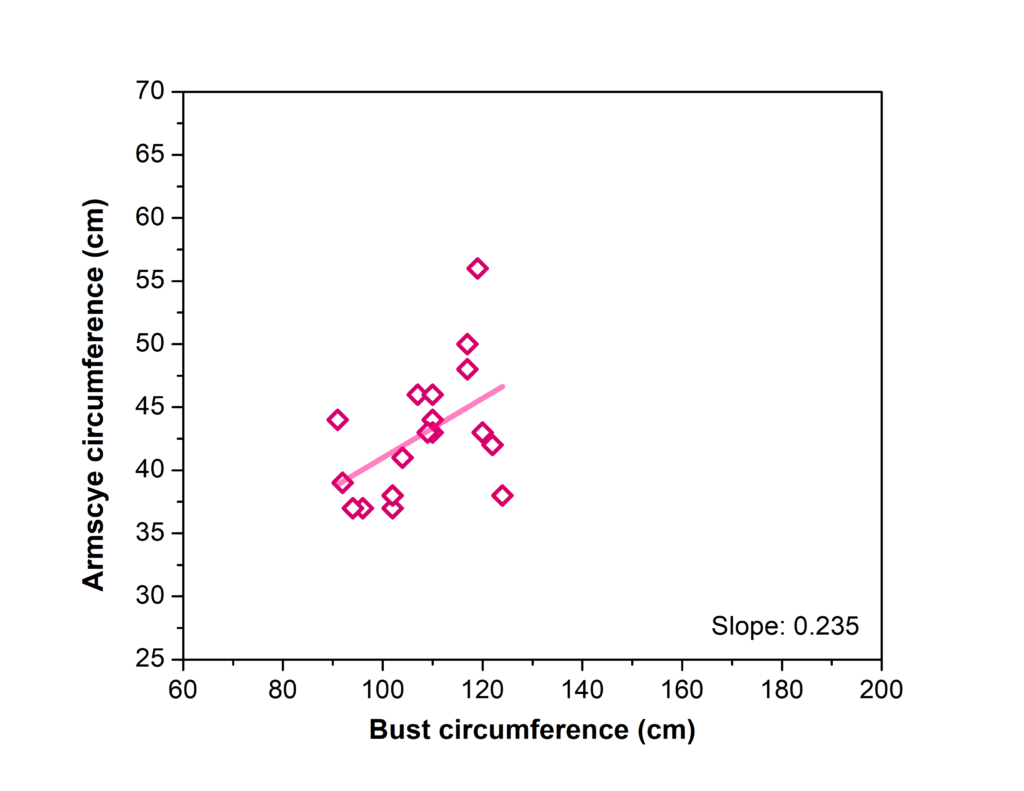
C. Bicep circumference
For the bicep circumference we also have the previous data plotted in gray in the background of the new data.
The measurements are found in a relatively narrow range, between 25-45 cm.
I would like to see more data for larger bust sizes, to see if the trend line is real or just a bad fitting based on insufficient data.
See discussion above about the bicep circumference being used in round yoke and raglan designs.
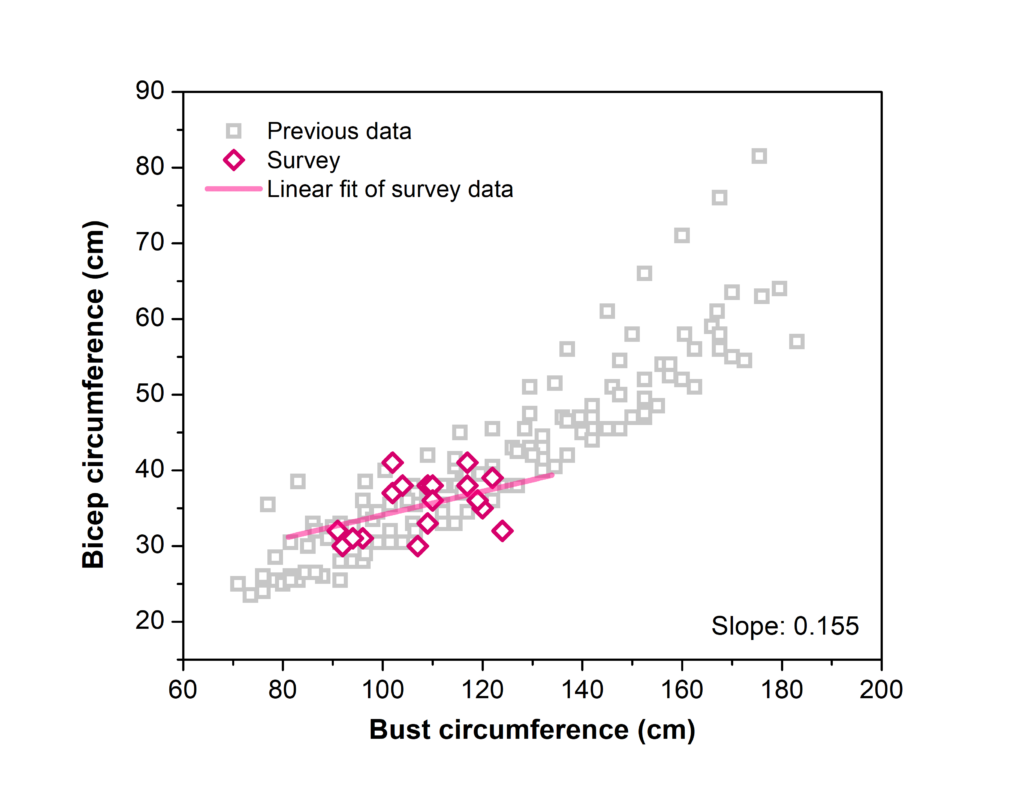
The bicep measurement is essential for any sleeved garment, with long or short sleeves.
The bicep measurement needs to be loose enough to allow full range of motion of the arm, which is why it’s taken while the arm is flexed.
D. Elbow circumference
I included the elbow circumference in the survey because sometimes a linear decrease in sleeve width from bicep to wrist is not the best in terms of fit.
The data is clustered within a narrow range between 20-30 cm, with one outlier data point.
The slope for this data is smaller than the one for the bicep measurements (10% vs. 15.5% for the bicep), which means that there is less variation in the shape of the lower arm than the upper arm.
This also means that, for a fitted sleeve, decreases can be slightly concentrated in the top part of the sleeve, between the lower end of the bicep and elbow.
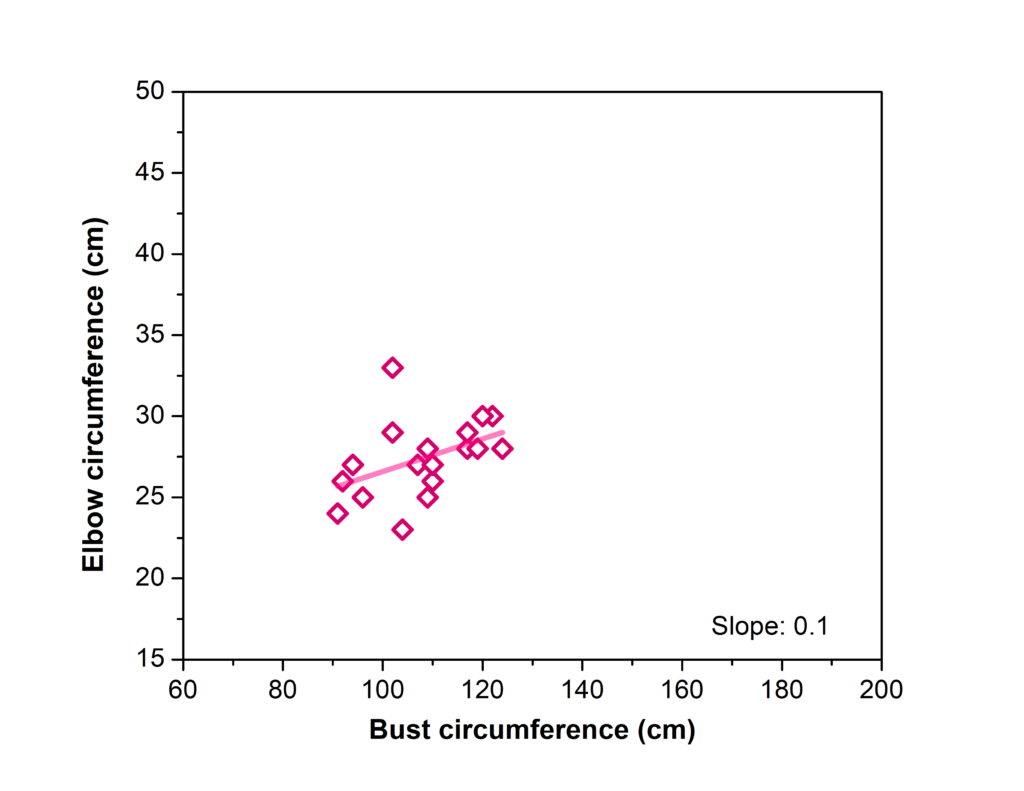
E. Wrist circumference
Just like in the case of the neck measurements, the wrist measurements don’t change much with the bust size.
The values range between 14-20 cm at all sizes, which means that an inelastic cuff must only go over a typical knuckle, which can be at 20-25 cm, depending on the hand size.
For men that would of course be slightly larger.
An elastic cuff can go down to the 14-20 cm value (not stretched), plus 1 cm ease, for a comfortable fit.
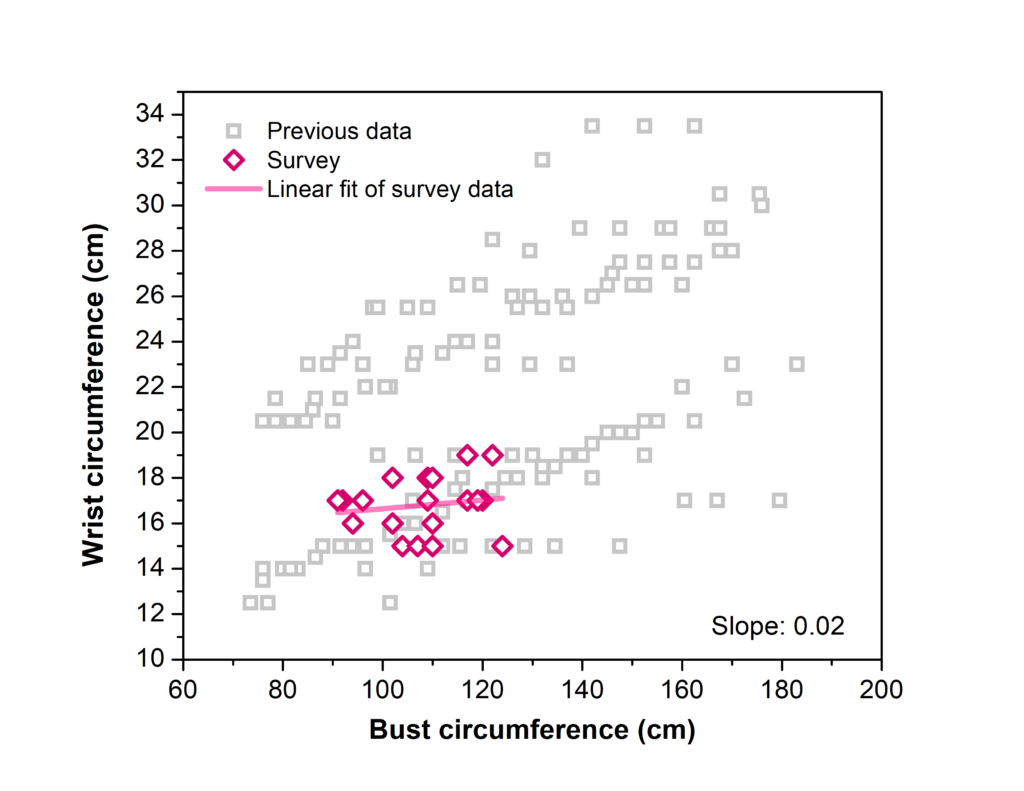
The great news is that wrist cuffs are the easiest to adapt to your wrist/knuckle size. See the wrist section in the “customizing fit” guide.
F. Shoulder circumference
The data for the shoulder circumference is mostly clustered, with two points that are outliers, but not unexpected.
The values range between 100-130 cm. The slope at 0.44 or 44% means that there’s some increase in the values as the bust measurements increase.
We do need more data for larger bust sizes to see if the slope stays the same or if it changes.
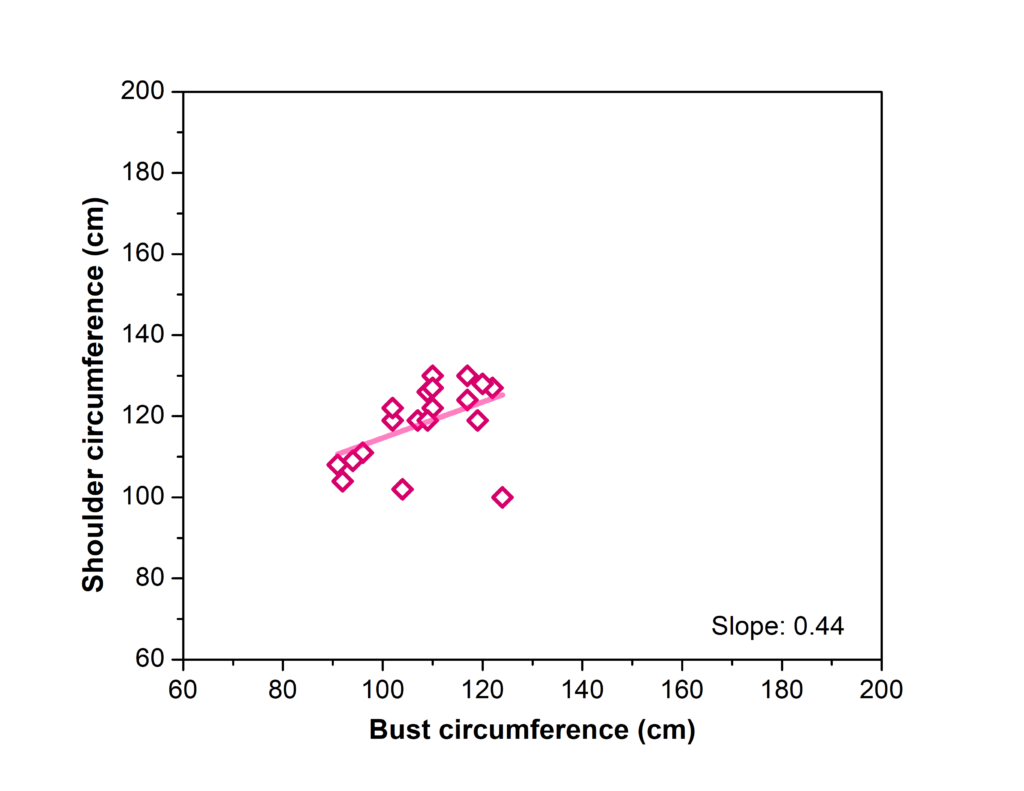
G. Shoulder length
This is a tricky measurement and the scattered data shows this.
The values vary between 7-17 cm, with an average at about 13 cm, which is the value I will keep using.
This is mostly important when designing fitted sleeve garments, as the sleeves on the other types of designs start way lower than the top of the shoulder.
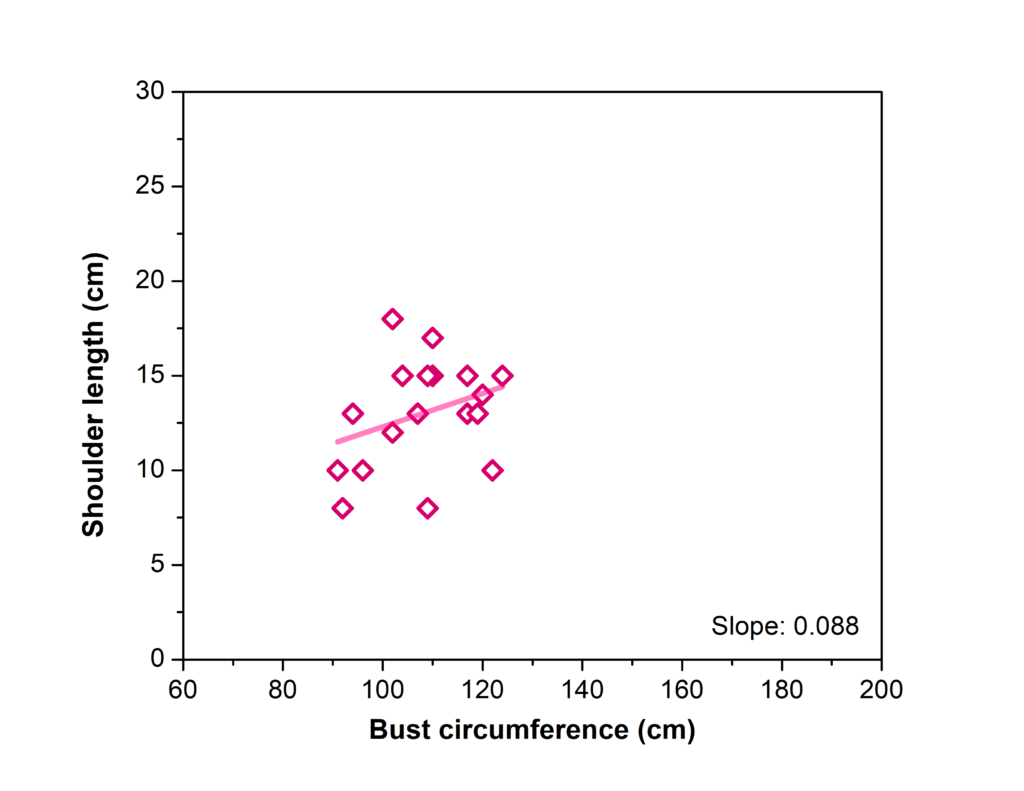
H. Shoulder width
The shoulder width, as opposed to length, takes into account both shoulders and the length at the bottom of the neck. In effect, it’s a line drawn parallel to the ground, from one shoulder to the next.
People with broad shoulders usually have a hard time finding sweater designs that fit well, especially when it comes to round yoke sweaters, which sometimes have a conical shape that doesn’t fit great on wider shoulders.
The survey data is clearly clustered and there’s an upward trend with larger bust sizes. However, the slope is not that steep, at 0.32 or 32%.
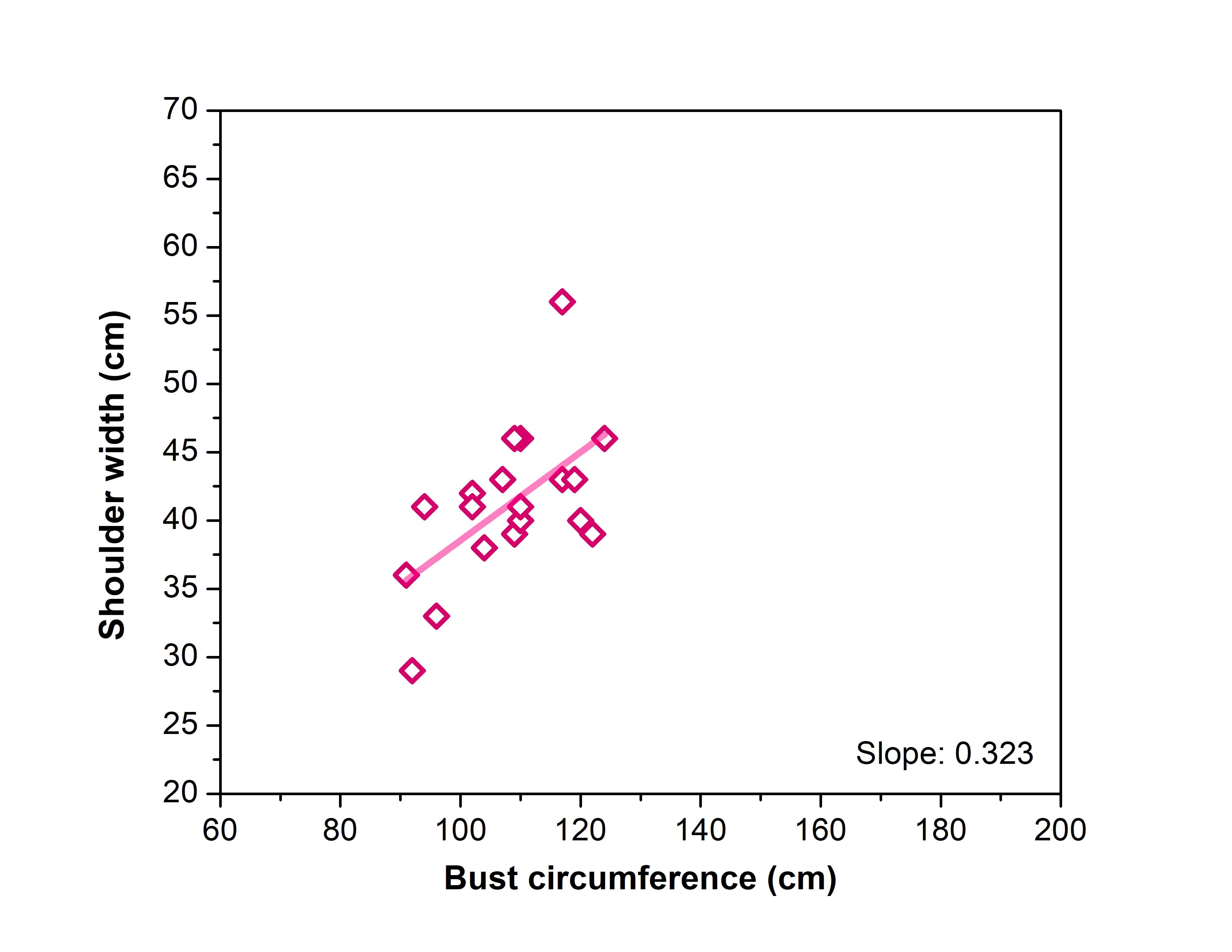
I have a hunch that the real slope is even smaller, but we won’t find that out until new data comes in.
I. Arm length
This is a measurement with a large variability and it mostly depends on your bone structure than anything else.
I could not fit the data with a curve, since it’s so scattered, but it varies between 45-63 cm, which I expected.
This is why sleeves should always be customized to fit the wearer.
We all have different arm lengths and, depending on where the sleeve starts in the garment design, we need to adapt the sleeve length either way.
Customizing sleeve length is easy. On simple, uniform fabrics, you add or skip some of the plain rows. You don’t touch the rows with shaping.
If working a stitch pattern or colorwork, you will change the distribution of the shaping stitches, instead of skipping rows.
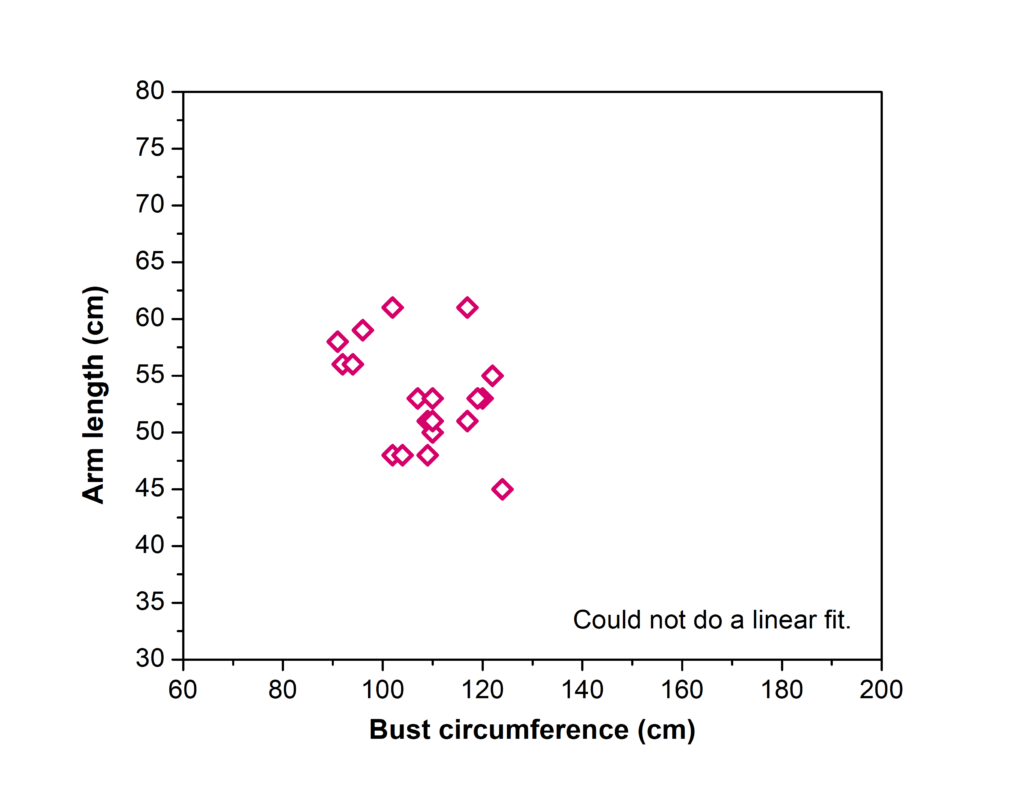
J. Upper bust circumference
This measurement is not usually included in designs because it’s tricky to take into account, but it’s good to have it to see just how big of a difference it makes in fitting a garment.
The slope is steeper than several other measurements and the data is clustered close to the fitting curve.
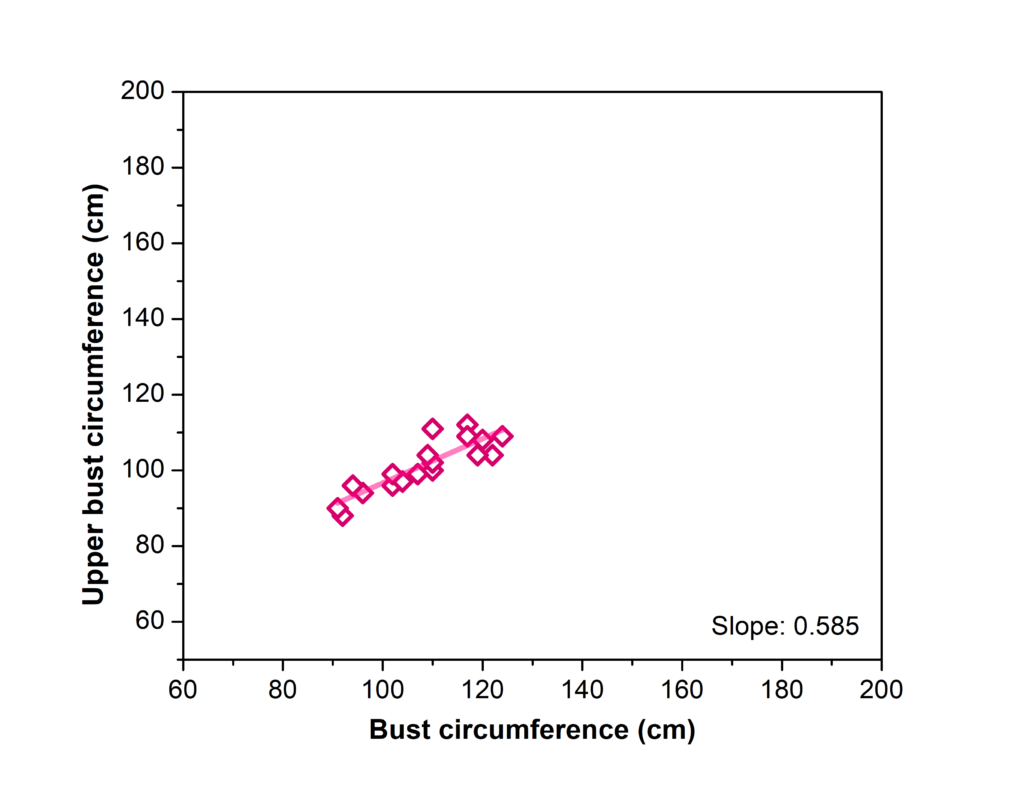
K. Bust circumference
This is the most important measurement in this article, as all the other measurements are plotted against it.
Obviously, the slope is 1, since each X value is equal to the Y value.
The graph shows that there is a lot of space to fill with new measurements.
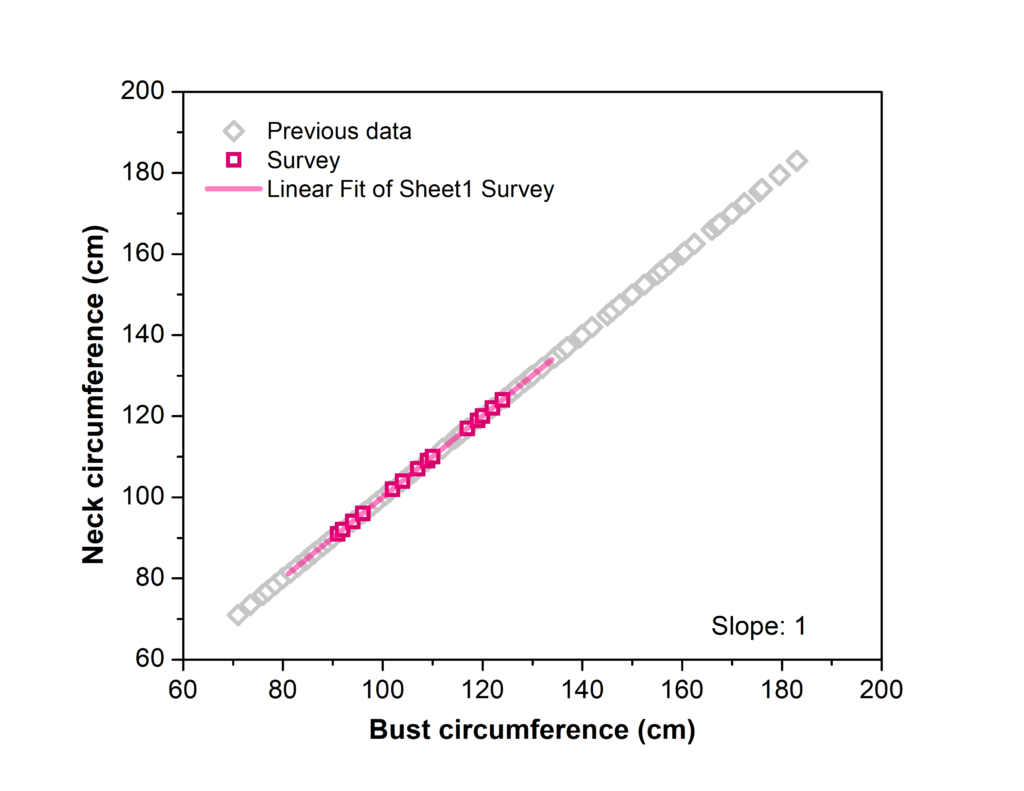
L. Under bust circumference
This is also a measurement that helps when designing fitted garments.
It gives a good estimate for the cup size that is required for a decent fit.
The data varies between 80-110 cm, with one outlier data point. As more data is accumulated for larger sizes, I’m expecting to see more scattering.
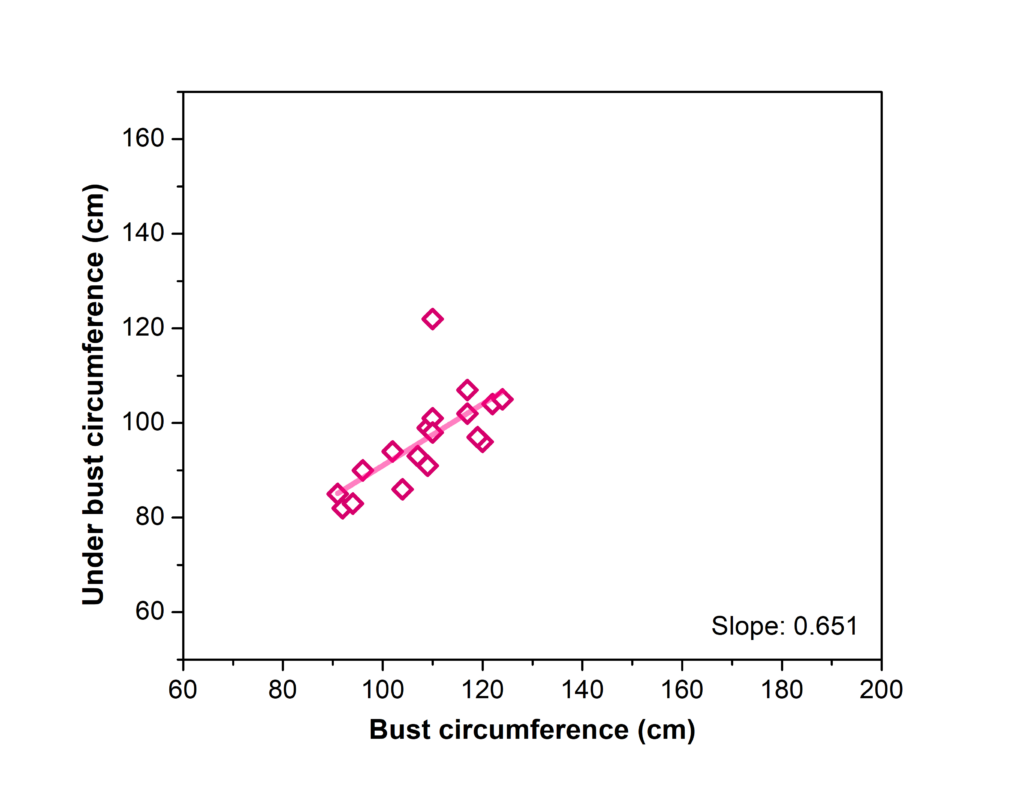
M. Waist circumference
Waist measurements are also useful when designing fitted garments (think cardigans, dresses, skirts).
The data in the survey show a clustered distribution with a higher slope, 0.825.
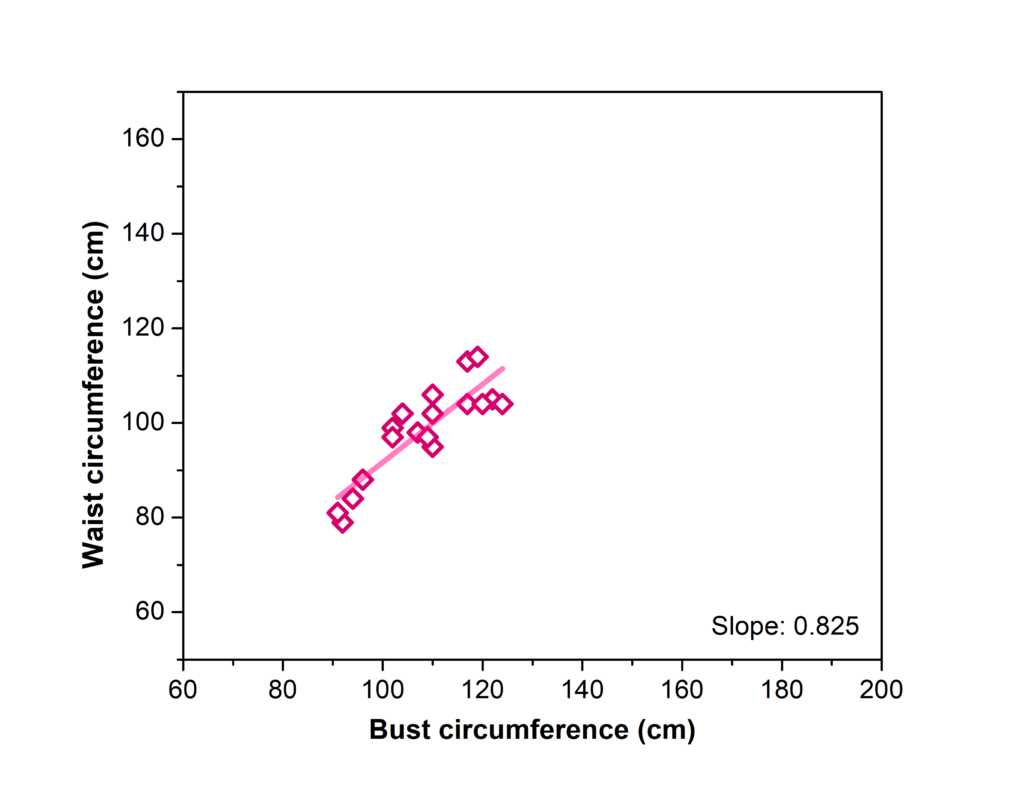
N-O. High hip and full hip circumferences
These two measurements are really useful when designing clothes that are meant to cover your back comfortably.
They both show clustering and high slopes – 0.95 and 0.87 respectively.
Many times these measurements are not considered when designing garments based on bust size only, but even in smaller sizes you will have hip measurements that are larger than the bust measurements.
This is entirely normal, as we humans have different shapes.
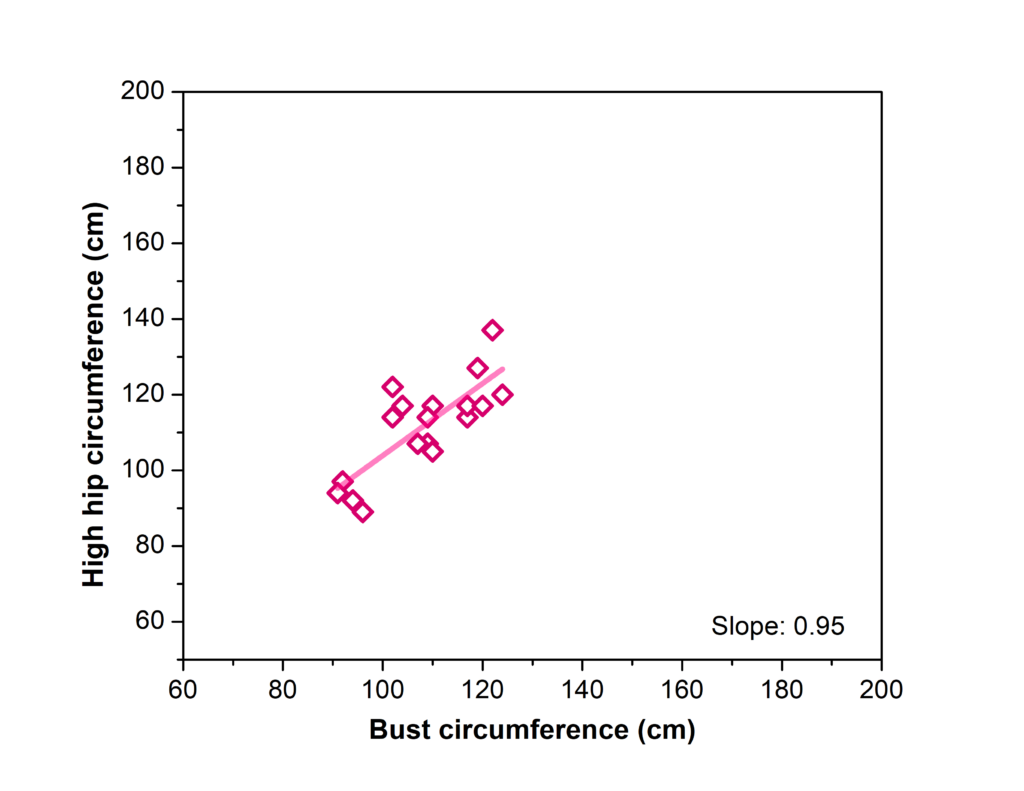
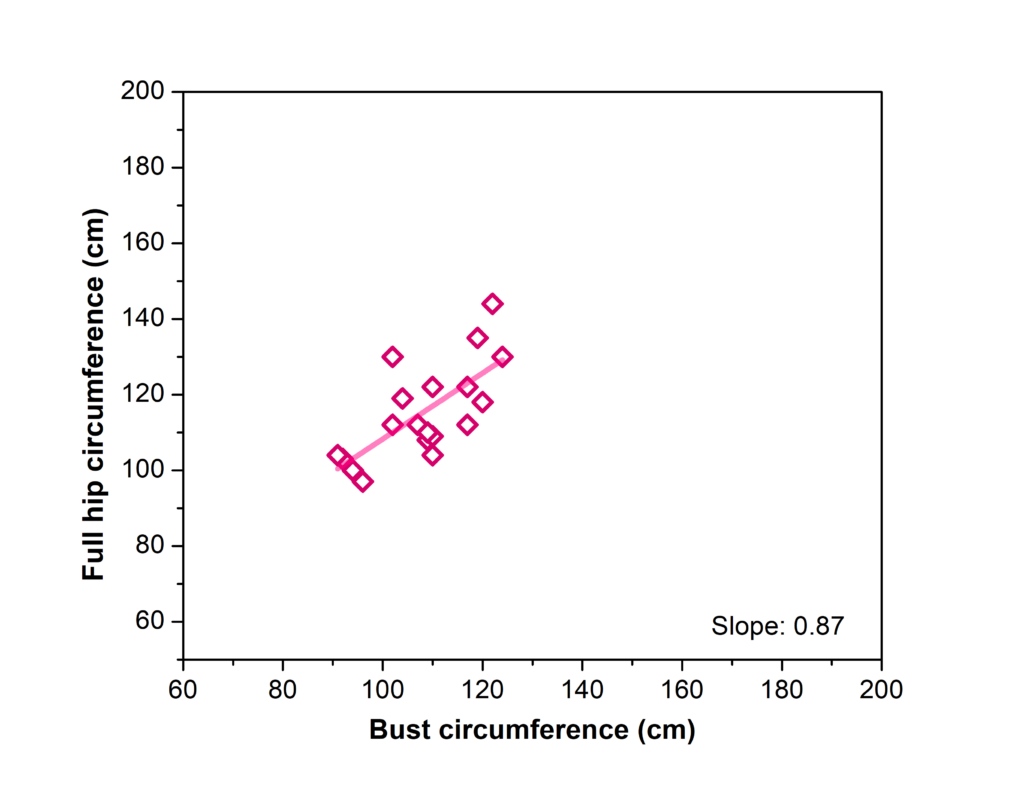
P-R. Back length to waist, high hip and full hip
All three datasets are dependent on the height and especially height of the torso and hips. All three of them show scattered data, which is expected, since we all have different skeletal proportions.
The length to waist is used for cropped tops. The data varies between 25 and 60 cm. The highest value could be due to an error in the form, as one of them doesn’t have a measurement to the high hip.
I was able to fit the data with a linear function, but more data will show if it’s real or just chance.
The length to high hip is generally used for “regular length” tops and the values range between 43-64 cm. I was not able to fit this data with a function, but maybe more data will make fitting possible.

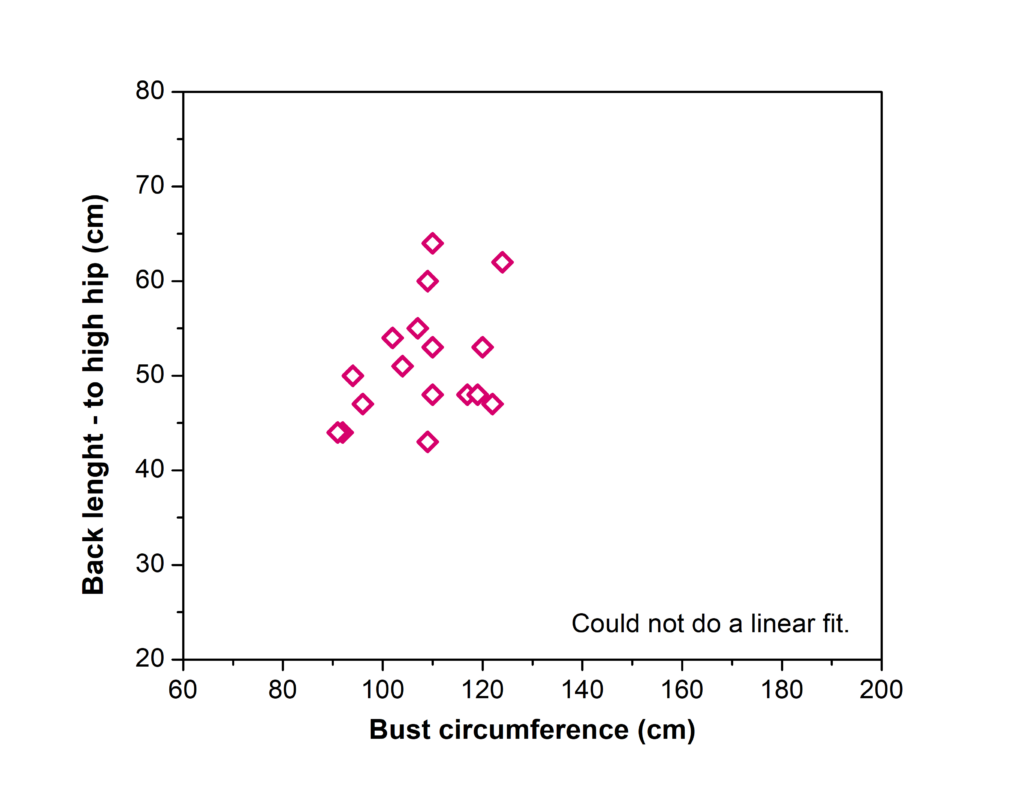
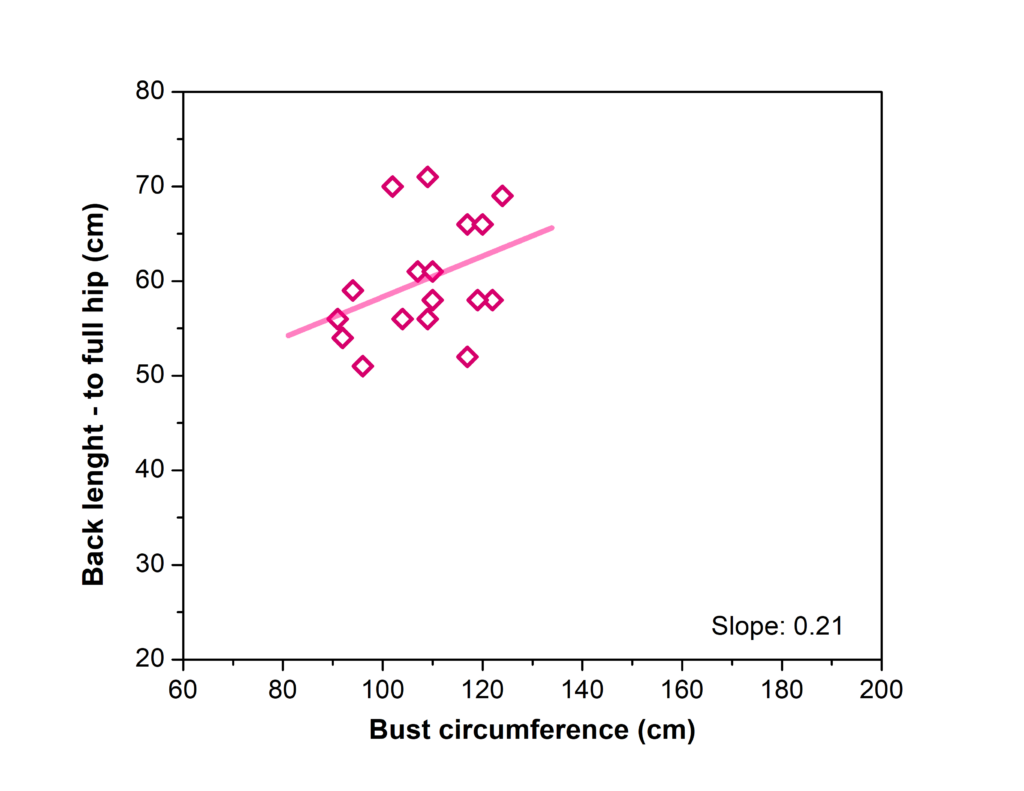
The length to full hip is regularly used for cardigans or longer sweaters that cover the back well even when you are active and need to bend or sit or do any normal activity.
The values are scattered between 50 and 70 cm, with a slope of 0.21. The data is scattered enough that I don’t trust the fitting, since we all have different torso lengths. More data will probably show how true this is.
Discussion
The data set includes 20 points for most of the measurements, where the data was available.
A few of the form submissions were not complete, so some sets of measurements have fewer than 20 points.
This is still a small sample size, so if you’d like to make the data more representative of the world’s population, please add your measurements here and save a copy for yourself, so you can make clothes that fit.
In the current dataset, the bust measurements range between 90-130 cm, with the full hip between 90-150 cm.
A broader range would be very helpful in the future.
The slope in the fitting curves is important to keep in mind because the Y axis varies a lot, so two fitting curves might look the same, but they might not have the same slope.
A higher slope means that the values increase faster as the bust size increases. A lower slope (close to 0) means that the values show very small increases from one size to the next.
This is important especially with regards to the neck and wrist measurements, which show that there isn’t a large variation in values as the bust size increases.
In garment design, this translates to necklines and wrist cuffs that are comfortable, regardless of the bust size.
In fact, these measurements should be supplemented by head and knuckle measurements, since these are the parts of the body that the neckline and the wrist cuff need to pass over.
Should I add those two measurements to the survey?
How does your data compare?
If you want to see your measurements in these graphs, make sure to fill out the form here (the more data points, the better).
I will process it on the first week of each month and update the graphs in the results section above.
Creating a custom fit
These measurements are used to create a general shape that I (and hopefully other designers) will use in designing garment patterns.
At the end of this project, I will extract data points on the fitting slope for each type of measurement and update the table of measurements that I published here.
It will also give me a good working idea of how much ease to include in the designs to offer good fit for a wide range of body shapes and sizes.
As always, these measurements will not fit you perfectly, since they are a standardized set.
You will need to learn to alter garment patterns to fit your specific shape and measurements.
I will prepare a separate article on how to do that and I will also include it in all my garment patterns, so everyone can have access to a good guide for fitting crochet garments.
Make sure you are subscribed to my email updates (and have confirmed your subscription) to find out when that article is ready and to participate in testing calls or to get coupons.
I will see you soon. Until then, happy hooking!
Hugs,
Andrea
